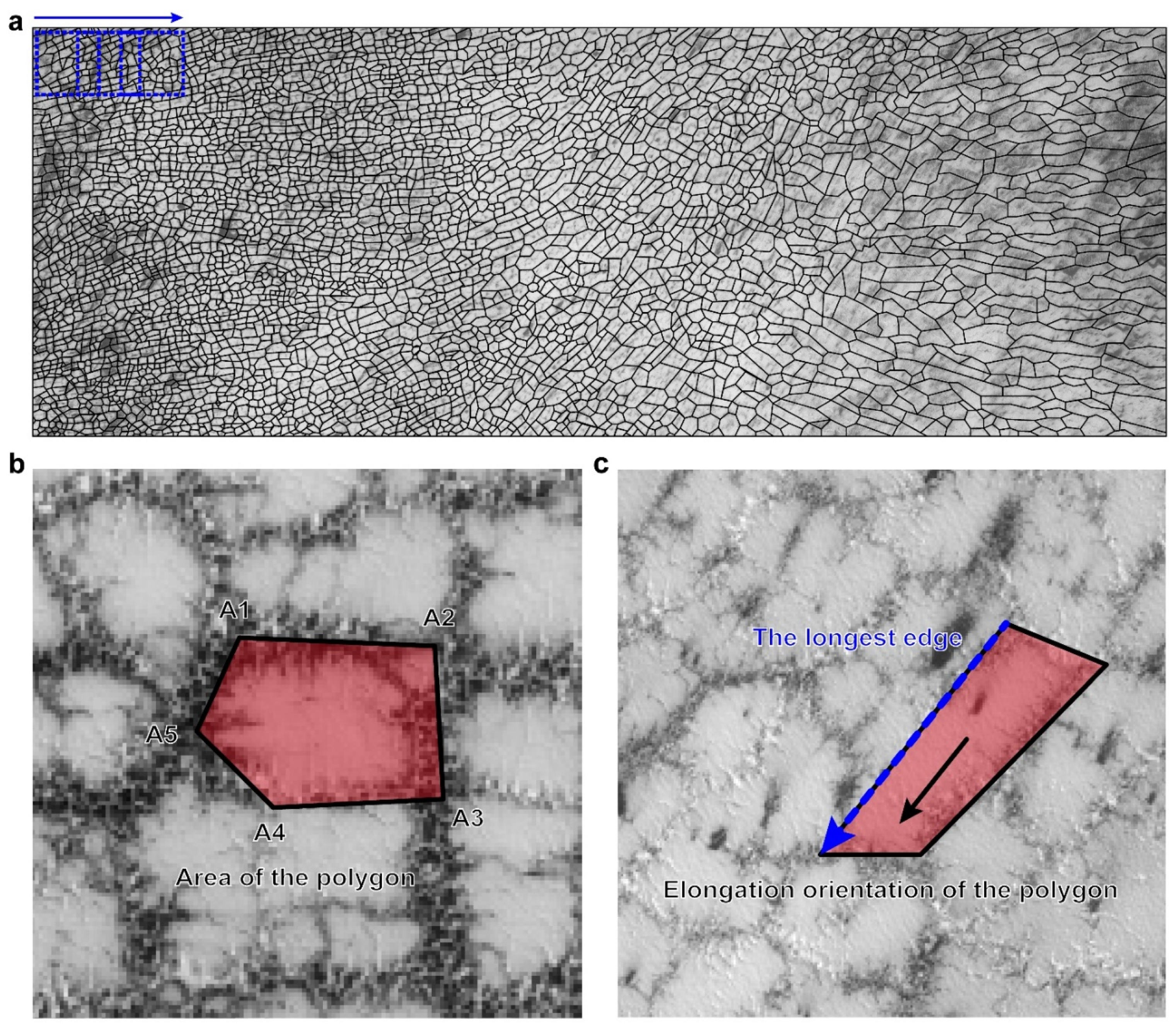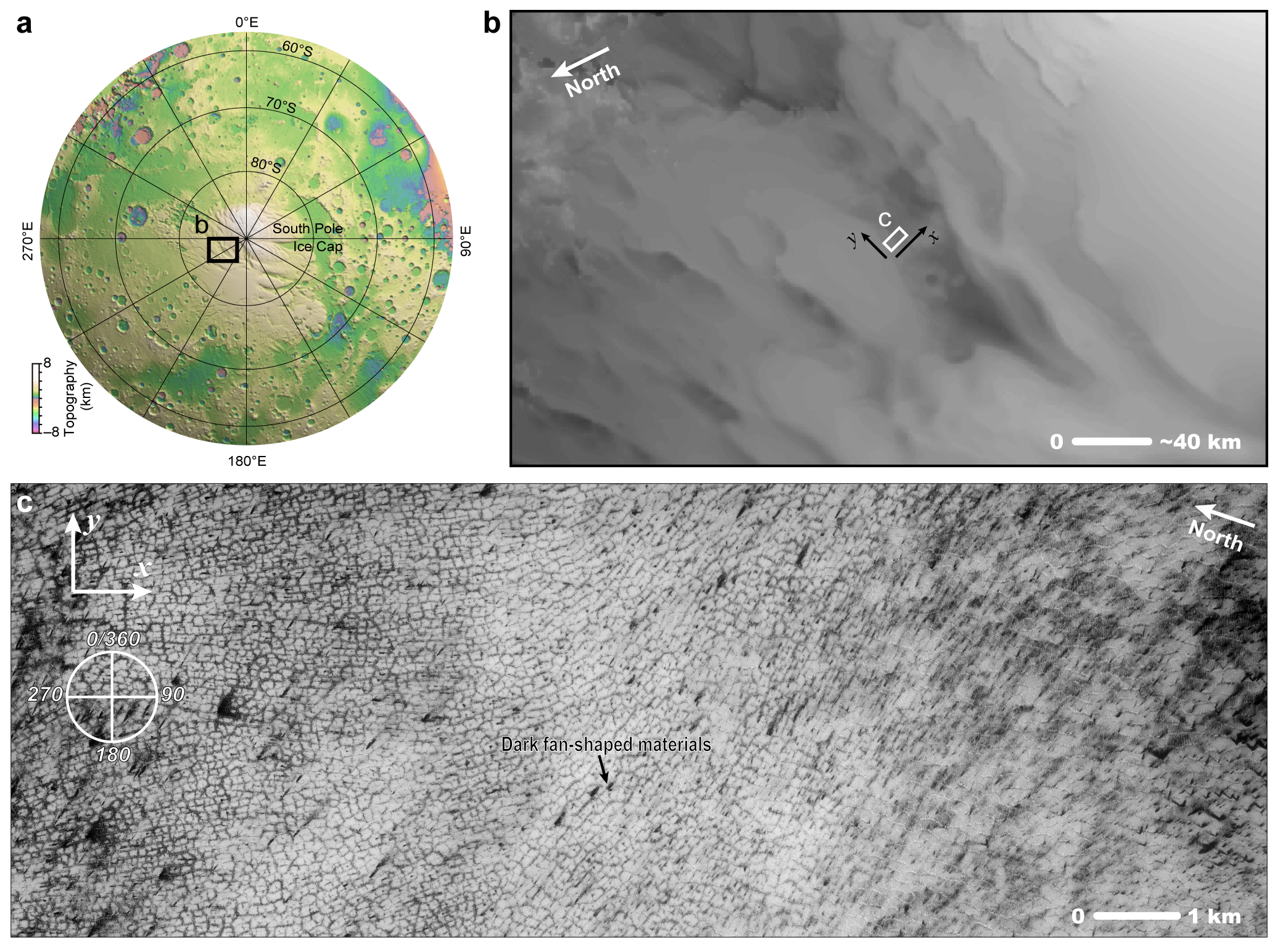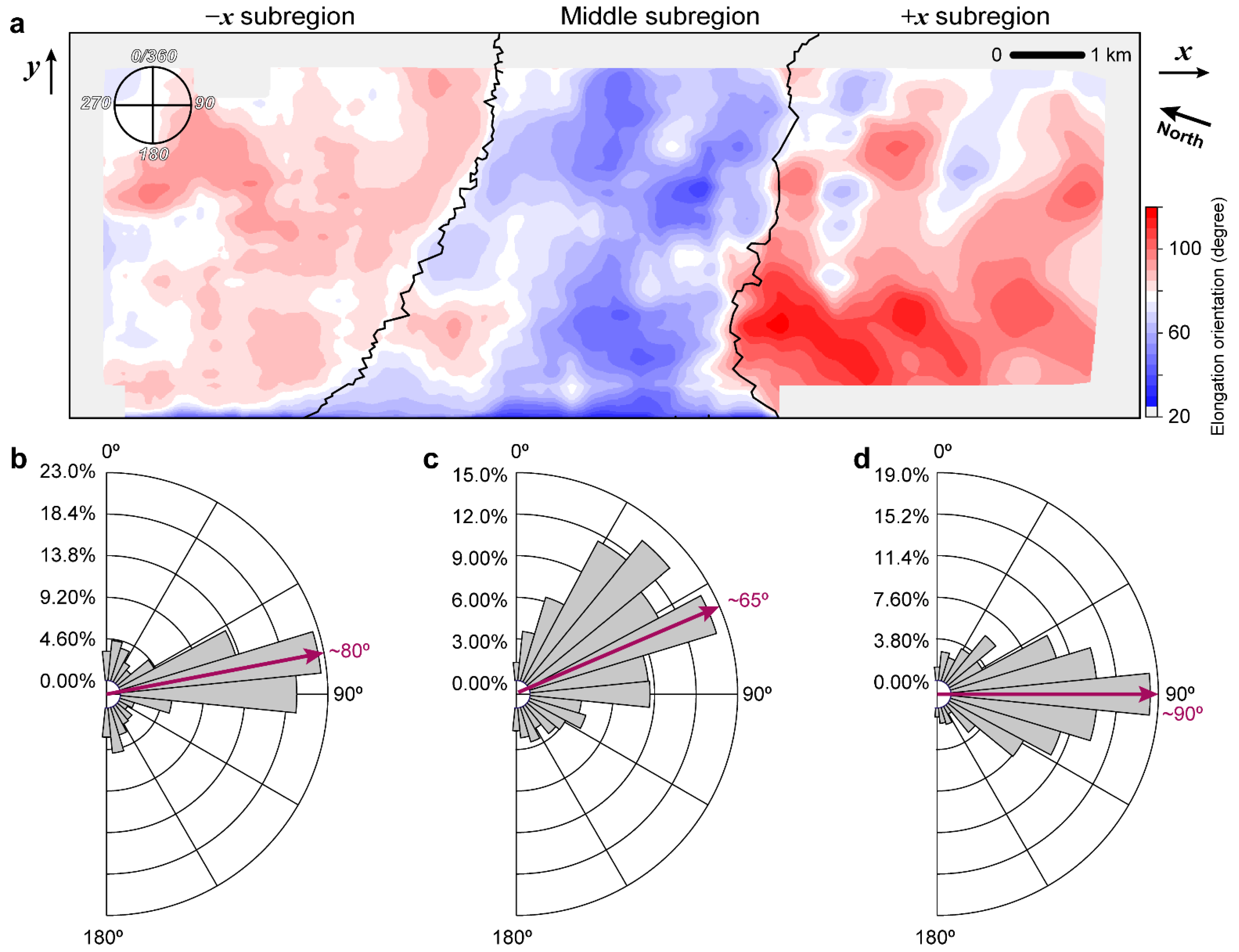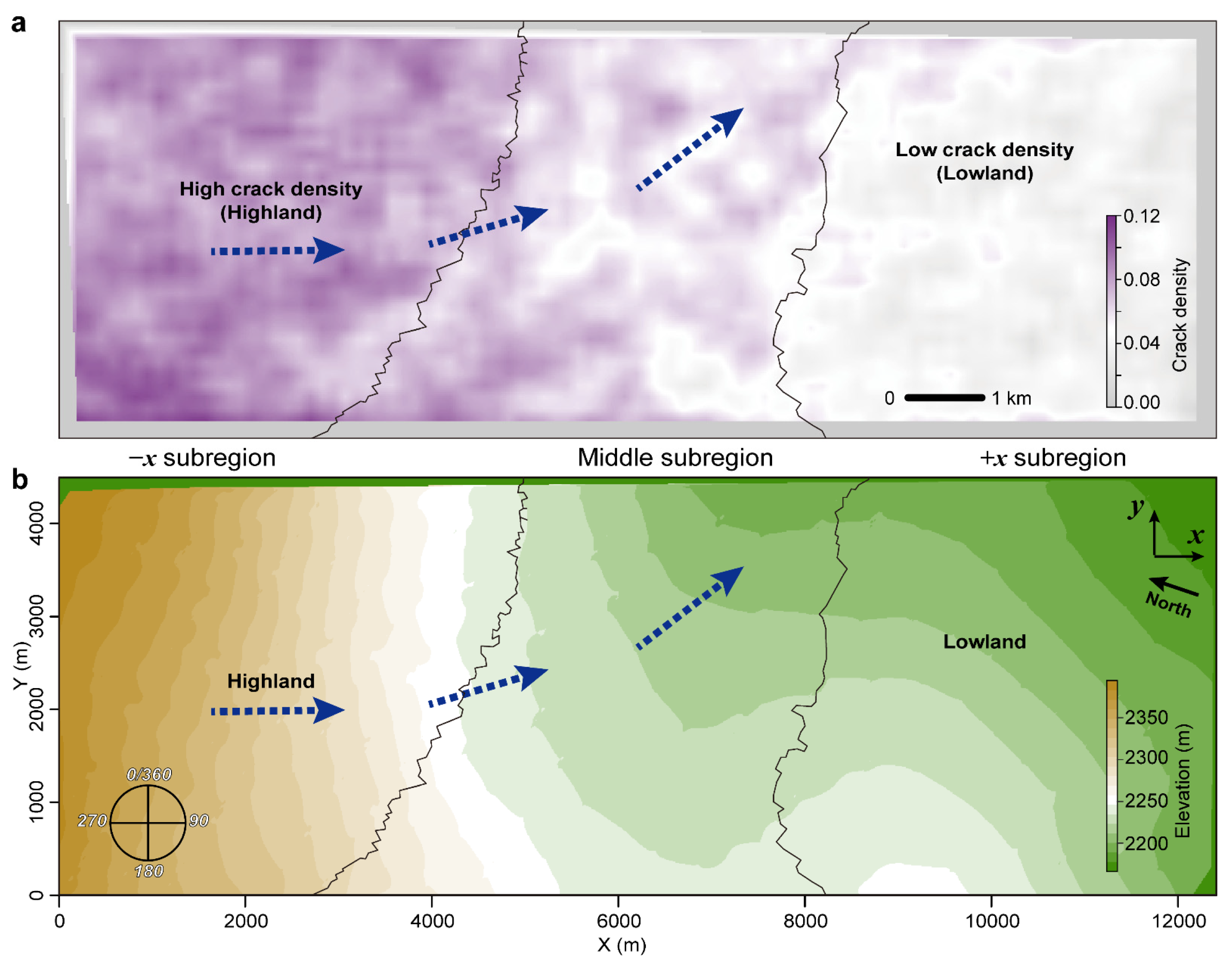A Polygonal Terrain on Southern Martian Polar Cap: Implications for Its Formation Mechanism
Abstract
:1. Introduction
2. Region of Study and the Methods of the Recognition for Polygon Properties
2.1. Region of Study
2.2. Recognition Process of the Polygons: Area, Orientation, and Polygon Edge Density

3. Recognition Results
3.1. Areal Distribution of the Polygons
3.2. Distribution of Elongation Orientation of the Polygons
3.3. Polygon Edge Density Distribution of the Polygons
4. Discussions
4.1. Possible Formation Mechanisms of the Three-Subregion Zone
4.2. Different Polygon Edge Density Distribution
4.3. Implication of Water/ice Activity on Polar Regions
5. Conclusions
Author Contributions
Funding
Data Availability Statement
Acknowledgments
Conflicts of Interest
References
- Hiesinger, H.; Head III, J.W. Characteristics and origin of polygonal terrain in southern Utopia Planitia, Mars: Results from Mars Orbiter Laser Altimeter and Mars Orbiter Camera data. J. Geophys. Res. Planets 2000, 105, 11999–12022. [Google Scholar] [CrossRef]
- Brooker, L.M.; Balme, M.R.; Conway, S.J.; Hagermann, A.; Barrett, A.M.; Collins, G.S.; Soare, R.J. Clastic polygonal networks around Lyot crater, Mars: Possible formation mechanisms from morphometric analysis. Icarus 2018, 302, 386–406. [Google Scholar] [CrossRef]
- Morison, A.; Labrosse, S.; Choblet, G. Sublimation-driven convection in Sputnik Planitia on Pluto. Nature 2021, 600, 419–423. [Google Scholar] [CrossRef] [PubMed]
- Yoshikawa, K. Origin of the polygons and the thickness of Vastitas Borealis Formation in Western Utopia Planitia on Mars. Geophys. Res. Lett. 2003, 30, 5-1–5-4. [Google Scholar] [CrossRef]
- Mangold, N. High latitude patterned grounds on Mars: Classification, distribution and climatic control. Icarus 2005, 174, 336–359. [Google Scholar] [CrossRef]
- Morgenstern, A.; Hauber, E.; Reiss, D.; van Gasselt, S.; Grosse, G.; Schirrmeister, L. Deposition and degradation of a volatile-rich layer in Utopia Planitia and implications for climate history on Mars. J. Geophys. Res. Planets 2007, 112, E06010. [Google Scholar] [CrossRef] [Green Version]
- Levy, J.; Head, J.; Marchant, D. Thermal contraction crack polygons on Mars: Classification, distribution, and climate implications from HiRISE observations. J. Geophys. Res. Planets 2009, 114, E01007. [Google Scholar] [CrossRef] [Green Version]
- Orgel, C.; Hauber, E.; van Gasselt, S.; Reiss, D.; Johnsson, A.; Ramsdale, J.D.; Smith, I.; Swirad, Z.M.; Séjourné, A.; Wilson, J.T.; et al. Grid mapping the northern plains of Mars: A new overview of recent water-and ice-related landforms in Acidalia Planitia. J. Geophys. Res. Planets 2019, 124, 454–482. [Google Scholar] [CrossRef] [Green Version]
- Séjourné, A.; Costard, F.; Swirad, Z.M.; Łosiak, A.; Bouley, S.; Smith, I.; Balme, M.R.; Orgel, C.; Ramsdale, J.D.; Hauber, E.; et al. Grid mapping the Northern Plains of Mars: Using morphotype and distribution of ice-related landforms to understand multiple ice-rich deposits in Utopia Planitia. J. Geophys. Res. Planets 2019, 124, 483–503. [Google Scholar] [CrossRef] [Green Version]
- Mellon, M.T. Small-scale polygonal features on Mars: Seasonal thermal contraction cracks in permafrost. J. Geophys. Res. Planets 1997, 102, 25617–25628. [Google Scholar] [CrossRef]
- Seibert, N.M.; Kargel, J.S. Small-scale Martian polygonal terrain: Implications for liquid surface water. Geophys. Res. Lett. 2001, 28, 899–902. [Google Scholar] [CrossRef]
- Lu, Y.; Liu, S.; Weng, L.; Wang, L.; Li, Z.; Xu, L. Fractal analysis of cracking in a clayey soil under freeze–thaw cycles. Eng. Geol. 2016, 208, 93–99. [Google Scholar] [CrossRef]
- Kieffer, H.H. Mars south polar spring and summer temperatures: A residual CO2 frost. J. Geophys. Res. Solid Earth 1979, 84, 8263–8288. [Google Scholar] [CrossRef]
- Byrne, S.; Ingersoll, A.P. A sublimation model for Martian south polar ice features. Science 2003, 299, 1051–1053. [Google Scholar] [CrossRef] [PubMed] [Green Version]
- Phillips, R.J.; Davis, B.J.; Tanaka, K.L.; Byrne, S.; Mellon, M.T.; Putzig, N.E.; Haberle, R.M.; Kahre, M.A.; Campbell, B.A.; Carter, L.M.; et al. Massive CO2 ice deposits sequestered in the south polar layered deposits of Mars. Science 2011, 332, 838–841. [Google Scholar] [CrossRef] [PubMed] [Green Version]
- Jian, J.-J.; Ip, W.-H. Seasonal patterns of condensation and sublimation cycles in the cryptic and non-cryptic regions of the South Pole. Adv. Space Res. 2009, 43, 138–142. [Google Scholar] [CrossRef]
- Portyankina, G.; Pommerol, A.; Aye, K.M.; Hansen, C.J.; Thomas, N. Polygonal cracks in the seasonal semi-translucent CO2 ice layer in Martian polar areas. J. Geophys. Res. Planets 2012, 117, E02006. [Google Scholar] [CrossRef] [Green Version]
- McGill, G.E.; Hills, L.S. Origin of giant Martian polygons. J. Geophys. Res. Planets 1992, 97, 2633–2647. [Google Scholar] [CrossRef]
- Lefort, A.; Russell, P.S.; Thomas, N.; McEwen, A.S.; Dundas, C.M.; Kirk, R.L. Observations of periglacial landforms in Utopia Planitia with the high resolution imaging science experiment (HiRISE). J. Geophys. Res. Planets 2009, 114, E04005. [Google Scholar] [CrossRef] [Green Version]
- Buczkowski, D.L.; Seelos, K.D.; Cooke, M.L. Giant polygons and circular graben in western Utopia basin, Mars: Exploring possible formation mechanisms. J. Geophys. Res. Planets 2012, 117, E08010. [Google Scholar] [CrossRef]
- Ulrich, M.; Hauber, E.; Herzschuh, U.; Härtel, S.; Schirrmeister, L. Polygon pattern geomorphometry on Svalbard (Norway) and western Utopia Planitia (Mars) using high-resolution stereo remote-sensing data. Geomorphology 2011, 134, 197–216. [Google Scholar] [CrossRef] [Green Version]
- DeCarlo, K.F.; Shokri, N. Salinity effects on cracking morphology and dynamics in 3-D desiccating clays. Water Resour. Res. 2014, 50, 3052–3072. [Google Scholar] [CrossRef]
- Shokri, N.; Zhou, P.; Keshmiri, A. Patterns of desiccation cracks in saline bentonite layers. Transp. Porous Media 2015, 110, 333–344. [Google Scholar] [CrossRef]
- Yang, B.; Yuan, J. Influence of soda content on desiccation cracks in clayey soils. Soil Sci. Soc. Am. J. 2019, 83, 1054–1061. [Google Scholar] [CrossRef]
- Li, D.; Yang, B.; Yang, C.; Zhang, Z.; Hu, M. Effects of salt content on desiccation cracks in the clay. Environ. Earth Sci. 2021, 80, 671. [Google Scholar] [CrossRef]
- Van Gasselt, S.; Reiss, D.; Thorpe, A.K.; Neukum, G. Seasonal variations of polygonal thermal contraction crack patterns in a south polar trough, Mars. J. Geophys. Res. Planets 2005, 110, E08002. [Google Scholar] [CrossRef] [Green Version]
- Kossacki, K.J.; Markiewicz, W.J.; Smith, M.D. Surface temperature of Martian regolith with polygonal features: Influence of the subsurface water ice. Planet. Space Sci. 2003, 51, 569–580. [Google Scholar] [CrossRef]
- Van Gasselt, S.; Hao, J. Systematic High-Resolution Remote-Sensing Investigation of Martian South Polar Landforms: Thermal Contraction Polygons. In EGU General Assembly Conference Abstracts; EGU General Assembly: Vienna, Austria, 2015; p. 7819. [Google Scholar]
- McEwen, A.S.; Eliason, E.M.; Bergstrom, J.W.; Bridges, N.T.; Hansen, C.J.; Delamere, W.A.; Grant, J.A.; Gulick, V.C.; Herkenhoff, K.E.; Keszthelyi, L.; et al. Mars reconnaissance orbiter’s high resolution imaging science experiment (HiRISE). J. Geophys. Res. Planets 2007, 112, E05S02. [Google Scholar] [CrossRef] [Green Version]
- Möhlmann, D.; Thomsen, K. Properties of cryobrines on Mars. Icarus 2011, 212, 123–130. [Google Scholar] [CrossRef]
- Martín-Torres, F.J.; Zorzano, M.-P.; Valentín-Serrano, P.; Harri, A.-M.; Genzer, M.; Kemppinen, O.; Rivera-Valentin, E.G.; Jun, I.; Wray, J.; Madsen, M.B.; et al. Transient liquid water and water activity at Gale crater on Mars. Nat. Geosci. 2015, 8, 357–361. [Google Scholar] [CrossRef]
- Rivera-Valentín, E.G.; Chevrier, V.F.; Soto, A.; Martínez, G. Distribution and habitability of (meta) stable brines on present-day Mars. Nat. Astron. 2020, 4, 756–761. [Google Scholar] [CrossRef] [PubMed]
- Dang, Y.N.; Xiao, L.; Xu, Y.; Zhang, F.; Huang, J.; Wang, J.; Zhao, J.N.; Komatsu, G.; Yue, Z. The polygonal surface structures in the Dalangtan Playa, Qaidam Basin, NW China: Controlling factors for their formation and implications for analogous Martian landforms. J. Geophys. Res. Planets 2018, 123, 1910–1933. [Google Scholar] [CrossRef]
- Dang, Y.; Zhang, F.; Zhao, J.; Wang, J.; Xu, Y.; Huang, T.; Xiao, L. Diverse polygonal patterned grounds in the northern Eridania basin, Mars: Possible origins and implications. J. Geophys. Res. Planets 2020, 125, e2020JE006647. [Google Scholar] [CrossRef]
- Nandakishore, P.; Goehring, L. Crack patterns over uneven substrates. Soft Matter 2016, 12, 2253–2263. [Google Scholar] [CrossRef] [Green Version]
- Orosei, R.; Lauro, S.E.; Pettinelli, E.; Cicchetti, A.; Coradini, M.; Cosciotti, B.; Di Paolo, F.; Flamini, E.; Mattei, E.; Pajola, M.; et al. Radar evidence of subglacial liquid water on Mars. Science 2018, 361, 490–493. [Google Scholar] [CrossRef] [Green Version]
- Forget, F.; Hourdin, F.; Fournier, R.; Hourdin, C.; Talagrand, O.; Collins, M.; Lewis, S.R.; Read, P.L.; Huot, J.P. Improved general circulation models of the Martian atmosphere from the surface to above 80 km. J. Geophys. Res. Planets 1999, 104, 24155–24175. [Google Scholar] [CrossRef]
- Price, P.B.; Nagornov, O.V.; Bay, R.; Chirkin, D.; He, Y.; Miocinovic, P.; Richards, A.; Woschnagg, K.; Koci, B.; Zagorodnov, V. Temperature profile for glacial ice at the South Pole: Implications for life in a nearby subglacial lake. Proc. Natl. Acad. Sci. USA 2002, 99, 7844–7847. [Google Scholar] [CrossRef] [Green Version]
- Zhang, L.; Zhang, J.; Mitchell, R.N.; Cao, P.; Liu, J. A thermal origin for super-high-frequency marsquakes. Icarus 2023, 390, 115327. [Google Scholar] [CrossRef]
- Smith, D.E.; Zuber, M.T.; Frey, H.V.; Garvin, J.B.; Head, J.W.; Muhleman, D.O.; Pettengill, G.H.; Phillips, R.J.; Solomon, S.C.; Zwally, H.J.; et al. Topography of the northern hemisphere of Mars from the Mars Orbiter Laser Altimeter. Science 1998, 279, 1686–1692. [Google Scholar] [CrossRef] [Green Version]
- Bridges, J.C.; Catling, D.C.; Saxton, J.M.; Swindle, T.D.; Lyon, I.C.; Grady, M.M. Alteration assemblages in Martian meteorites: Implications for near-surface processes. Space Sci. Rev. 2001, 96, 365–392. [Google Scholar] [CrossRef]
- Moyano-Cambero, C.E.; Trigo-Rodríguez, J.M.; Benito, M.I.; Alonso-Azcárate, J.; Lee, M.R.; Mestres, N.; Martínez-Jiménez, M.; Martín-Torres, F.J.; Fraxedas, J. Petrographic and geochemical evidence for multiphase formation of carbonates in the Martian orthopyroxenite Allan Hills 84001. Meteorit. Planet. Sci. 2017, 52, 1030–1047. [Google Scholar] [CrossRef] [Green Version]
- Sleep, N.H. Martian plate tectonics. J. Geophys. Res. Planets 1994, 99, 5639–5655. [Google Scholar] [CrossRef]
- Clark, B.R.; Mullin, R.P. Martian glaciation and the flow of solid CO2. Icarus 1976, 27, 215–228. [Google Scholar] [CrossRef]




Publisher’s Note: MDPI stays neutral with regard to jurisdictional claims in published maps and institutional affiliations. |
© 2022 by the authors. Licensee MDPI, Basel, Switzerland. This article is an open access article distributed under the terms and conditions of the Creative Commons Attribution (CC BY) license (https://creativecommons.org/licenses/by/4.0/).
Share and Cite
Zhang, L.; Lu, Y.; Zhang, J. A Polygonal Terrain on Southern Martian Polar Cap: Implications for Its Formation Mechanism. Remote Sens. 2022, 14, 5789. https://doi.org/10.3390/rs14225789
Zhang L, Lu Y, Zhang J. A Polygonal Terrain on Southern Martian Polar Cap: Implications for Its Formation Mechanism. Remote Sensing. 2022; 14(22):5789. https://doi.org/10.3390/rs14225789
Chicago/Turabian StyleZhang, Lei, Yang Lu, and Jinhai Zhang. 2022. "A Polygonal Terrain on Southern Martian Polar Cap: Implications for Its Formation Mechanism" Remote Sensing 14, no. 22: 5789. https://doi.org/10.3390/rs14225789






